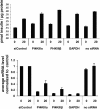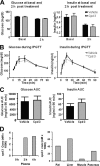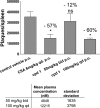Anti-hepatitis C virus activity and toxicity of type III phosphatidylinositol-4-kinase beta inhibitors
- PMID: 22825118
- PMCID: PMC3457382
- DOI: 10.1128/AAC.00946-12
Anti-hepatitis C virus activity and toxicity of type III phosphatidylinositol-4-kinase beta inhibitors
Abstract
Type III phosphatidylinositol-4-kinase beta (PI4KIIIβ) was previously implicated in hepatitis C virus (HCV) replication by small interfering RNA (siRNA) depletion and was therefore proposed as a novel cellular target for the treatment of hepatitis C. Medicinal chemistry efforts identified highly selective PI4KIIIβ inhibitors that potently inhibited the replication of genotype 1a and 1b HCV replicons and genotype 2a virus in vitro. Replicon cells required more than 5 weeks to reach low levels of 3- to 5-fold resistance, suggesting a high resistance barrier to these cellular targets. Extensive in vitro profiling of the compounds revealed a role of PI4KIIIβ in lymphocyte proliferation. Previously proposed functions of PI4KIIIβ in insulin secretion and the regulation of several ion channels were not perturbed with these inhibitors. Moreover, PI4KIIIβ inhibitors were not generally cytotoxic as demonstrated across hundreds of cell lines and primary cells. However, an unexpected antiproliferative effect in lymphocytes precluded their further development for the treatment of hepatitis C.
Figures





Similar articles
-
Phosphatidylinositol 4-kinase III beta is essential for replication of human rhinovirus and its inhibition causes a lethal phenotype in vivo.Antimicrob Agents Chemother. 2013 Jul;57(7):3358-68. doi: 10.1128/AAC.00303-13. Epub 2013 May 6. Antimicrob Agents Chemother. 2013. PMID: 23650168 Free PMC article.
-
PI4KIII inhibitor enviroxime impedes the replication of the hepatitis C virus by inhibiting PI3 kinases.J Antimicrob Chemother. 2018 Dec 1;73(12):3375-3384. doi: 10.1093/jac/dky327. J Antimicrob Chemother. 2018. PMID: 30219827
-
Class III phosphatidylinositol 4-kinase alpha and beta are novel host factor regulators of hepatitis C virus replication.J Virol. 2009 Oct;83(19):10058-74. doi: 10.1128/JVI.02418-08. Epub 2009 Jul 15. J Virol. 2009. PMID: 19605471 Free PMC article.
-
Metabolism of phosphatidylinositol 4-kinase IIIα-dependent PI4P Is subverted by HCV and is targeted by a 4-anilino quinazoline with antiviral activity.PLoS Pathog. 2012;8(3):e1002576. doi: 10.1371/journal.ppat.1002576. Epub 2012 Mar 8. PLoS Pathog. 2012. PMID: 22412376 Free PMC article.
-
2-Alkyloxazoles as potent and selective PI4KIIIβ inhibitors demonstrating inhibition of HCV replication.Bioorg Med Chem Lett. 2014 Aug 15;24(16):3714-8. doi: 10.1016/j.bmcl.2014.07.015. Epub 2014 Jul 12. Bioorg Med Chem Lett. 2014. PMID: 25065492
Cited by
-
Enterovirus Replication Organelles and Inhibitors of Their Formation.Front Microbiol. 2020 Aug 20;11:1817. doi: 10.3389/fmicb.2020.01817. eCollection 2020. Front Microbiol. 2020. PMID: 32973693 Free PMC article. Review.
-
Phosphatidylinositol 4-kinase III beta is essential for replication of human rhinovirus and its inhibition causes a lethal phenotype in vivo.Antimicrob Agents Chemother. 2013 Jul;57(7):3358-68. doi: 10.1128/AAC.00303-13. Epub 2013 May 6. Antimicrob Agents Chemother. 2013. PMID: 23650168 Free PMC article.
-
Host-Targeting Agents to Prevent and Cure Hepatitis C Virus Infection.Viruses. 2015 Nov 2;7(11):5659-85. doi: 10.3390/v7112898. Viruses. 2015. PMID: 26540069 Free PMC article. Review.
-
Negative charge and membrane-tethered viral 3B cooperate to recruit viral RNA dependent RNA polymerase 3D pol.Sci Rep. 2017 Dec 11;7(1):17309. doi: 10.1038/s41598-017-17621-6. Sci Rep. 2017. PMID: 29230036 Free PMC article.
-
Phosphoinositides in the hepatitis C virus life cycle.Viruses. 2012 Oct 19;4(10):2340-58. doi: 10.3390/v4102340. Viruses. 2012. PMID: 23202467 Free PMC article. Review.
References
MeSH terms
Substances
LinkOut - more resources
Full Text Sources
Other Literature Sources

